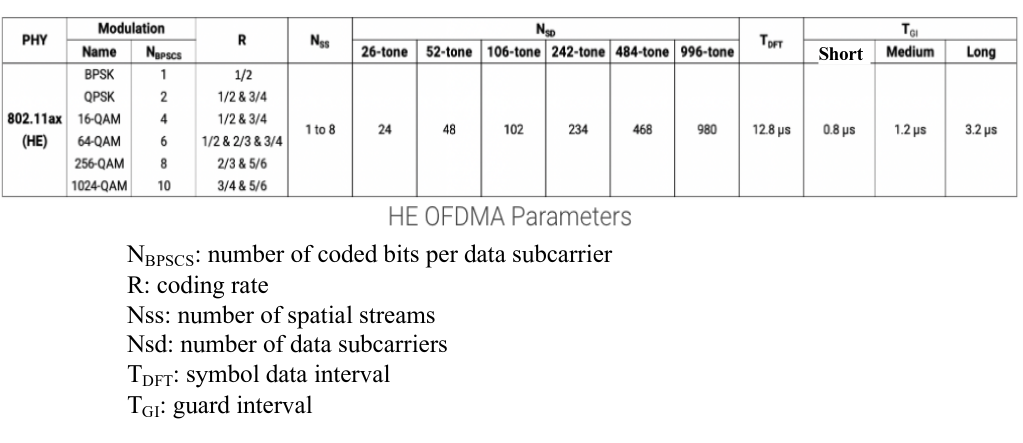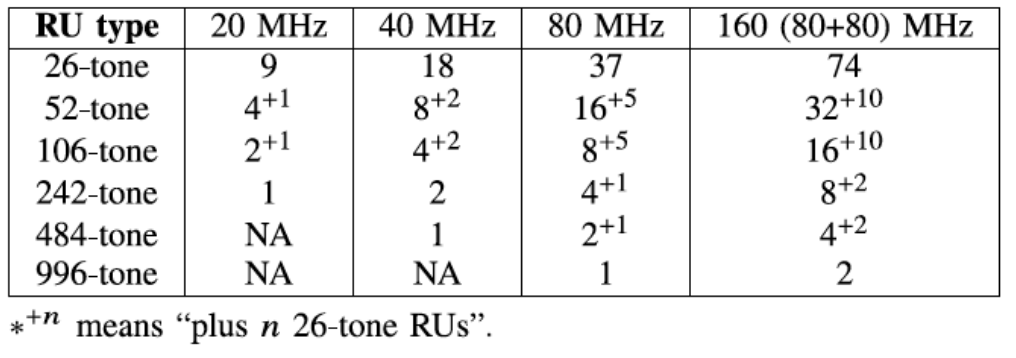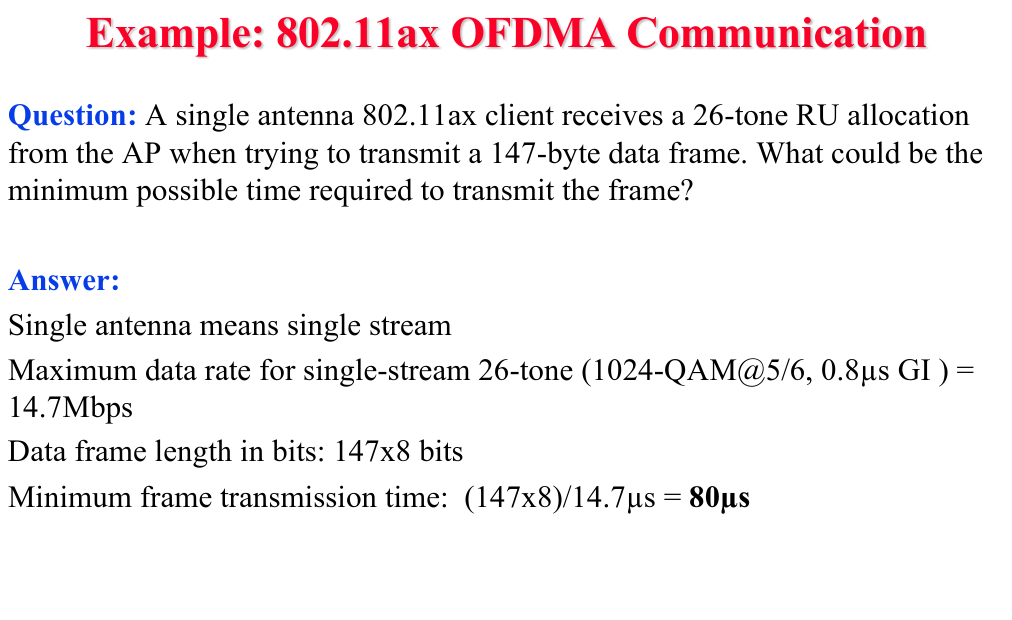WiFi 2
Contents
Highest data rate isn't always the best. Have to consider the SNR.
Data rate = Symbol rate * Data bits per symbol- Chip - Code bits in a symbol
IEEE 802.11b - 1999
- Uses the Direct Sequence Spread Spectrum
- 1 bit/symbol
- 10 chips/symbol
802.11-1997
- 1/2 rate binary convolution encoding
- 2 bits/symbol
- 11 chips/symbol
- DQPSK
Data Rate = Encoding rate * Frequency * Data rate / chip rate
DQPSK = 1/2 * 22 MHz / 11 chips per symbol * 2 data bits per symbol = 2 megabits per second
802.11b-1999
1/2 rate binary convolution encoder at 8 bits/symbol, 8 chips/symbol
Complementary Code Keying (CCK)
Data Rate = Encoding rate * Frequency * Data rate / chip rate
CCK = 1/2 * 22 * 8/8 = 11 Mbps
Example Question
1/2 rate (1/2 chips per Hz)
8 chips to code a symbol
16 QAM
22 MHz
It will take 2 Hz to produce one chip.
22 Mhz / 2 = 11 Mcps (Megachips per second)
11/8 = 1.375 - Chips per second / Chips per symbol
log2 16 = 4
1.375 * 4 = 5.5 Mbps
OFDM
Bits per symbol depends on the modulation order and subcarrier structure.
Total number of subcarriers = channel bandwidth / subcarrier spacing.
There are three categories of subcarriers
- Data - Data
- Pilot - Known symbols to check synchronisation
- Guard - Sort of like dummy channels
Each OFDM is carried over all data subscribers in parallel.
- $M$-ary modulation - $ log_2 {M} $ bits per data subcarrier
- i.e. 16QAM is $ log_2 16 = 4 $ bits per data subcarrier
Number of raw coded bits = $ log_2 {M} $ * number of data subcarriers
Impacts of Error Coding on Data Bits Per Symbol
Coded bit stream = original data bits + code bits
So, data bits = coded bits - code bits
We often use this as ratio/rate - x/y - x data bits for y coded bits.
Data bits per symbol = coding rate * log_2 M * number of data subcarriers
Parameters affecting WiFi data rate
- Modulation - affects number of bits per second
- Coding - affects error correction overhead
- Guard interval - affects symbol rate
- Channel width - affects number of data subcarriers
- MIMO streams - overall throughput
IEEE802.11a-1999
- 5GHz
- Uses OFDM
- 20 MHz channel width
- 64 subcarriers
- 6 guard subcarriers at each side
- 4 pilot subcarriers
- 48 data subcarriers to use
- Symbol interval of 4 microseconds
- 0.25 million symbols per second
- 3200ns (data) + 800ns (guard)
- Supports BPSK, QPSK, 16QAM, 64QAM
- Supports 1/2, 2/3, 3/4 coding rate
- Supports 8 (as opposed to 4x3=12) different data rates, 6 Mbps up to 54 Mbps - depending on the modulation and coding scheme (MCS)
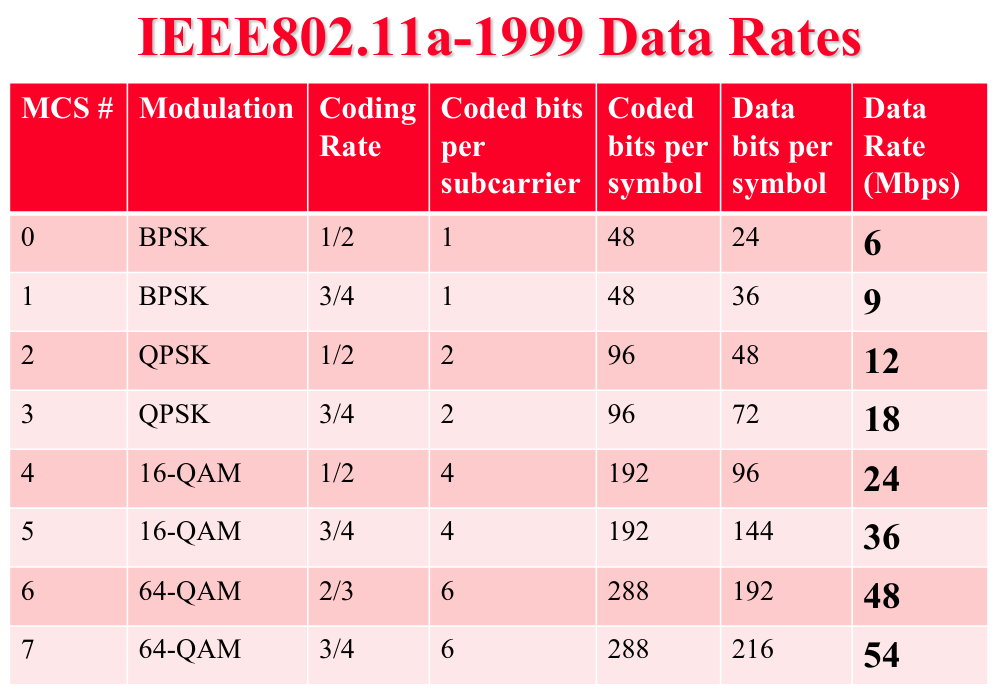
IEEE802.11g-2003
- Achieved 54Mbps on 2.4GHz using OFDM
IEEE802.11n-2009
- First spec to use MIMO
- Frame aggregation - multiple frames in one
- Reduced IFS (SIFS is 2 us instead of 10 us)
- Greenfield Mode - Can disable support for a/b/g (shorter and higher rate preamble)
- Dual Band - 2.4 and 5 GHz
- Lower FEC overhead - 5/6 instead of 3/4
- Channel Bonding - Can combine two 20 MHz channels to form a 40 MHz channel
- Shorter Guard Interval - 400ns instead of 800ns
- More OFDM subcarriers - Shorter GI in time domain, less guard carriers needed
- 4 guard carriers (per side) instead of 6 (per side)
- 52 instead of 48 data carriers (20 MHz channels)
- 108 (52 * 2 + 4) data carriers in 40 MHz channels (no guard channels needed between)
Guard Interval
Generally, guard interval = 4 x multipath delay spread
If agreed, a guard interval of 400ns can be used.
(3200ns + 400ns GI)
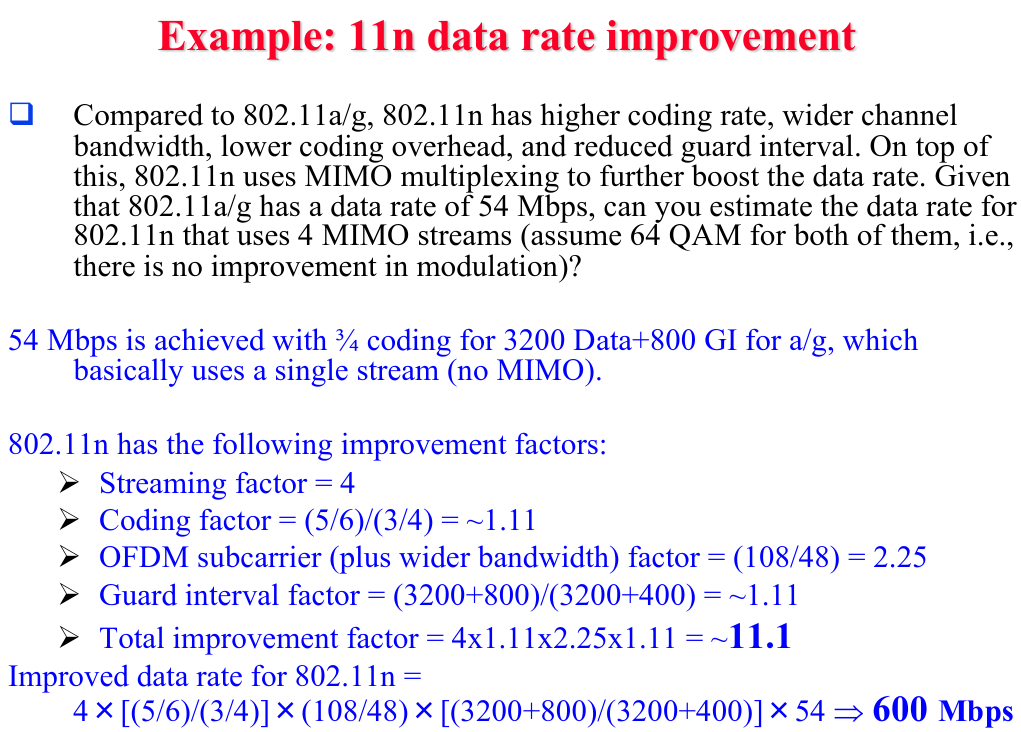

- Single Stream Data Rate - https://www.cablefree.net/wirelesstechnology/wireless-lan/data-rates-in-802-11n
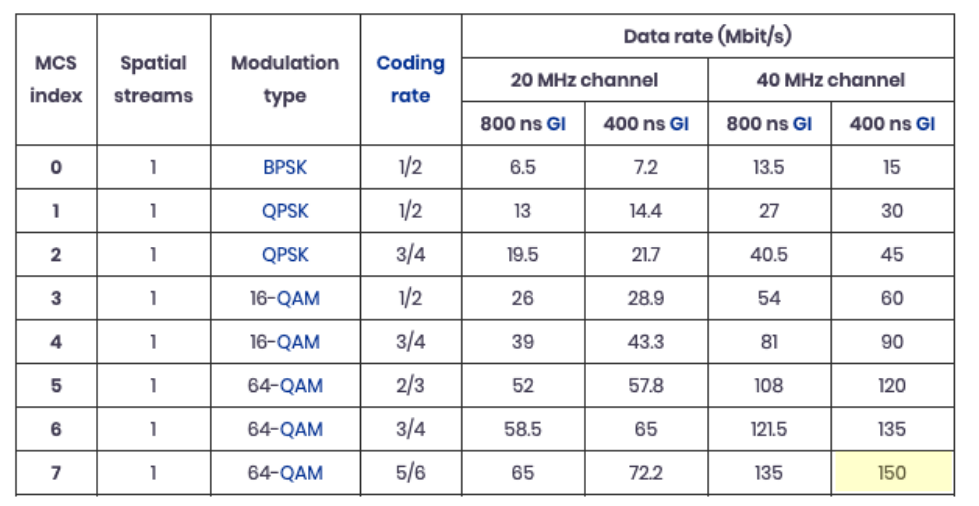
- Multi Stream Data Rate - https://www.cablefree.net/wirelesstechnology/wireless-lan/data-rates-in-802-11n
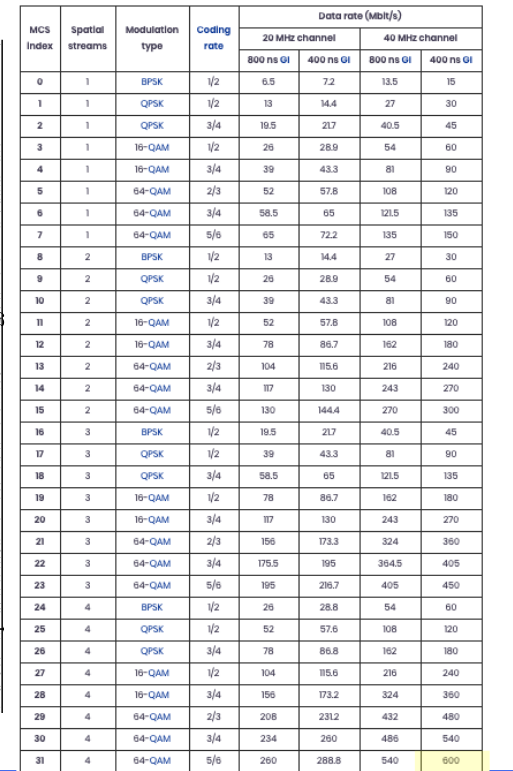
Frame aggregation
Each layer has Service Data Units (SDUs) as inputs.
Each layer makes Protocol Data Units (PDUs) as outputs to communicate with the corresponding layer at the other end.
Note: PDUs create overhead from their headers.
Frame Aggregation: Multiple SDUs in one PDUs.
All SDUs must have the same transmitter and receiver address
Channel State Information (CSI)
High Throughput Control field in the wireless packet to exchange CSI data.
Receivers can derive the CSI from the pilots, but the transmitter cannot derive - and needs to be notified.
IEEE 802.11ac
- 5 GHz only
- 20, 40, 80, 160 MHz channels
- 52+4, 108+6, 234+8, 468+16 data subcarriers -
data+pilot - Up to 256QAM
- Up to 8 MIMO streams
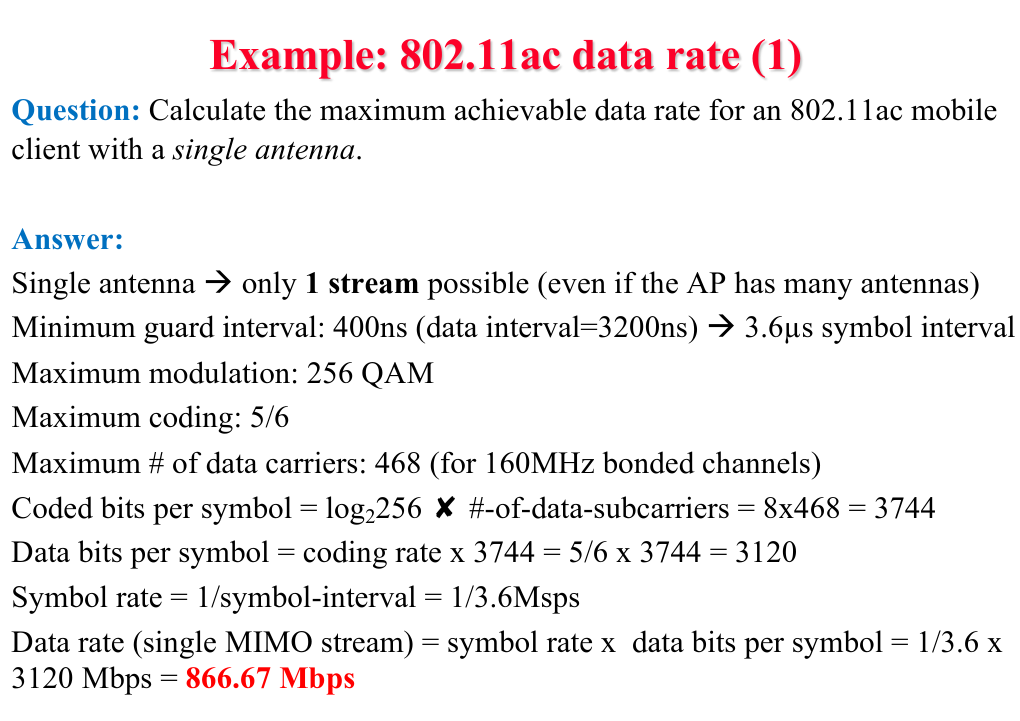

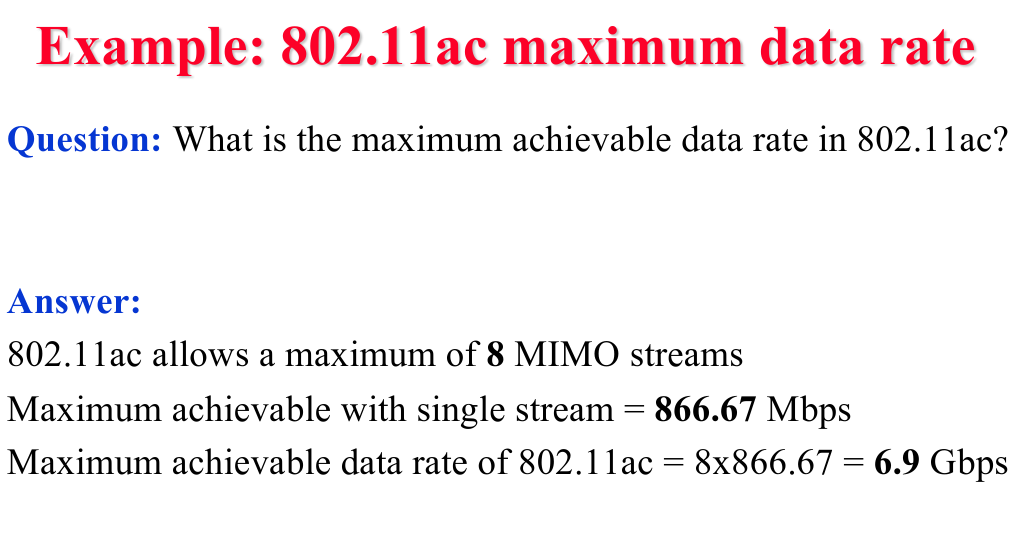
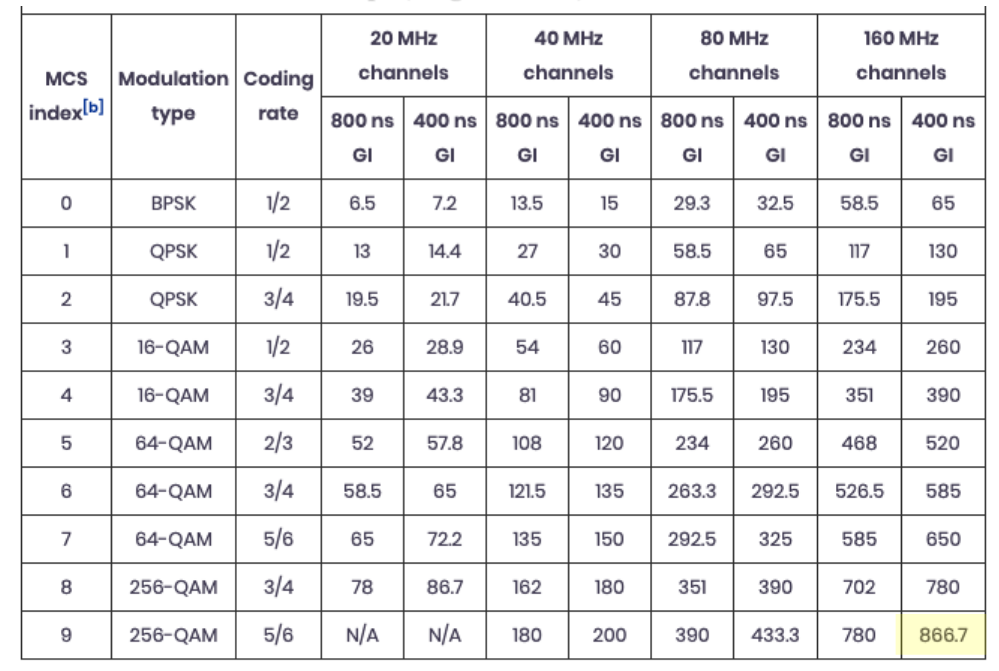
Multi-User MIMO
MIMO - Uncorrelated spatial beams, separated by $\lambda / 4$ or $\lambda / 2$
MU-MIMO - Two single antennas users can act as one multi-antenna device. The users are unaware of this configuration
Beamforming can be used to direct the different streams.
802.11ac improves over 802.11n in three dimensions
- Higher channel bandwidth
- More spatial streams
- More data bits per subcarrier
IEEE 802.11ax
Previous evolutions focused on increasing the speed - however it is hard to attain that actual throughput due to congestion, collisions and interference.
802.11ax instead aims on attaining high efficiency - Works efficiently in dense deployments.
- Supports 2.4 GHz and 5 GHz
- Max coding rate: 5/6 (no change)
- Max channel width: 40 MHz @ 2.4 GHz; 160 MHz at 5 GHz (no change)
- Max MIMO streams: 8 (no change)
- Max modulation rate: 1024QAM (10 bits)
- Increased symbol interval - to address longer delay spread in challenging environments
- Symbol data interval increased to 12.8 us
- Guard interval increased to 0.8 us, 1.6 us or 3.2 us
- OFDM subcarrier spacing reduced to 78.125 kHz
- Total subcarriers = data + pilot + guard + DC + null
- 20 MHz - 256 subcarriers, 234 data subcarriers
- 40 MHz - 512 subcarriers, 468 data subcarriers
- 80 MHz - 1024 subcarriers, 980 data subcarriers
- 160 MHz - 2014 subcarriers, 1960 data subcarriers
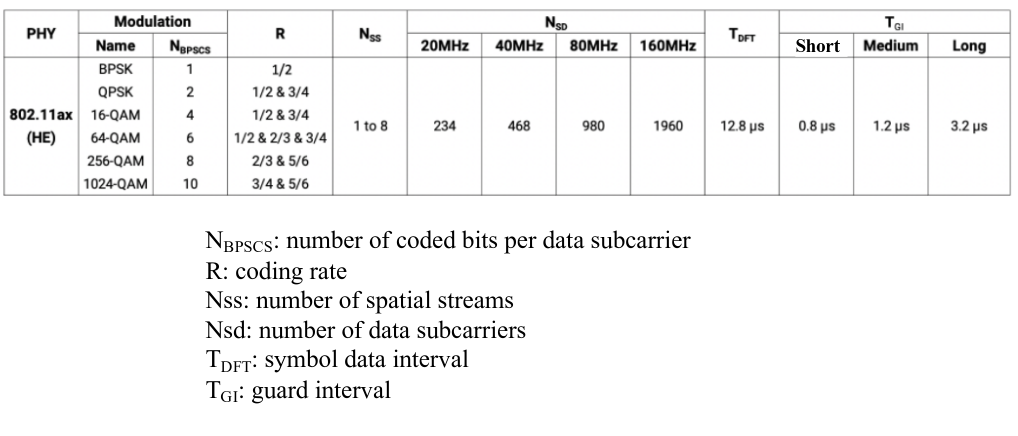

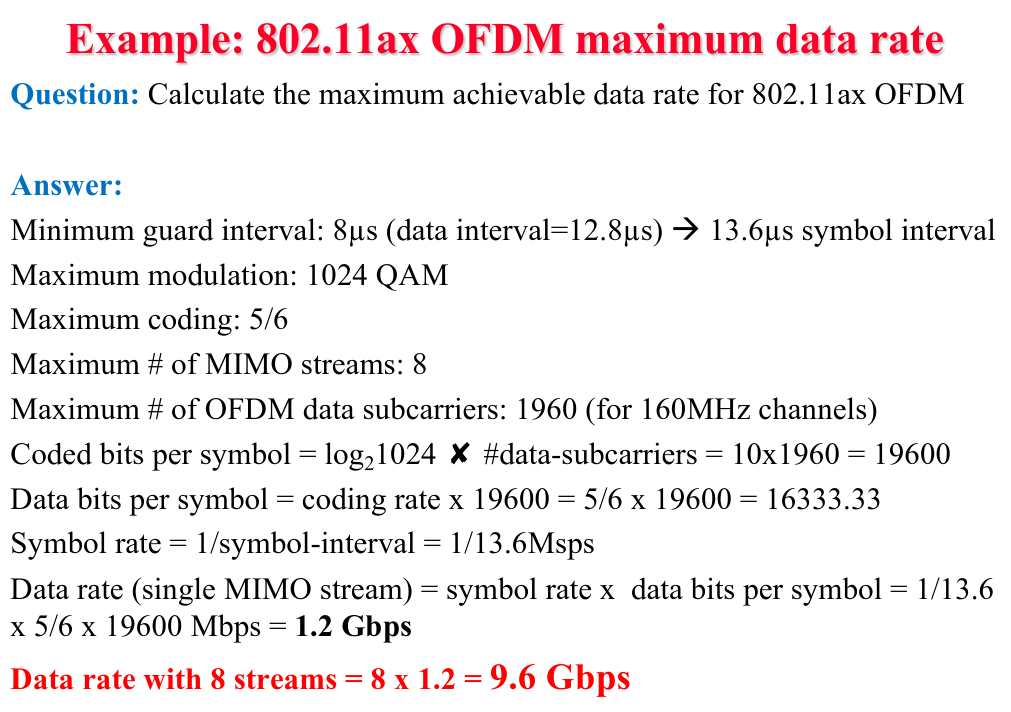
OFDMA - Orthogonal Frequency Division Multiple Access
- 2D frequency and time allocation
- Split into Resource Units (RU)
- Subcarriers of 78.125 kHz
- Subcarriers are grouped into RUs called tones
- 26, 54, 106, 242, 484 or 996 tones per station.
- Each tone consists of a single subcarrier of 78.125 kHz
- Smallest resource allocation / tone is 26 * 78.125 kHz = 2031.25 kHz ~= 2 MHz
- Largest resource allocation / tone - 996 * 78.125 kHz = 77812.5 kHz ~= 80 MHz
- A station can have a maximum of two 996 tones
